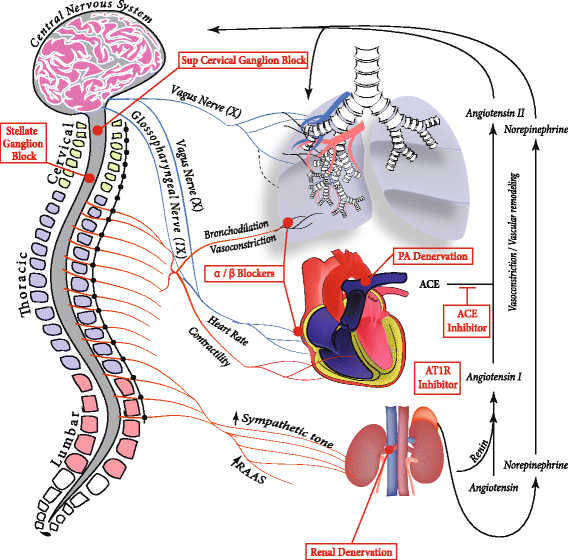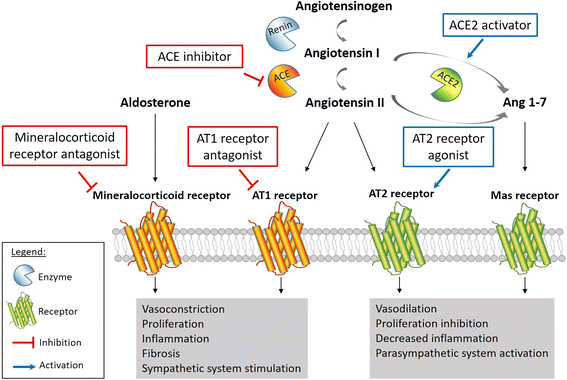Autonomic nervous system involvement in pulmonary arterial hypertension
- PMID: 29202826
- PMCID: PMC5715548
- DOI: 10.1186/s12931-017-0679-6
Autonomic nervous system involvement in pulmonary arterial hypertension
Abstract
Pulmonary arterial hypertension (PAH) is a chronic pulmonary vascular disease characterized by increased pulmonary vascular resistance (PVR) leading to right ventricular (RV) failure. Autonomic nervous system involvement in the pathogenesis of PAH has been demonstrated several years ago, however the extent of this involvement is not fully understood. PAH is associated with increased sympathetic nervous system (SNS) activation, decreased heart rate variability, and presence of cardiac arrhythmias. There is also evidence for increased renin-angiotensin-aldosterone system (RAAS) activation in PAH patients associated with clinical worsening. Reduction of neurohormonal activation could be an effective therapeutic strategy for PAH. Although therapies targeting adrenergic receptors or RAAS signaling pathways have been shown to reverse cardiac remodeling and improve outcomes in experimental pulmonary hypertension (PH)-models, the effectiveness and safety of such treatments in clinical settings have been uncertain. Recently, novel direct methods such as cervical ganglion block, pulmonary artery denervation (PADN), and renal denervation have been employed to attenuate SNS activation in PAH. In this review, we intend to summarize the multiple aspects of autonomic nervous system involvement in PAH and overview the different pharmacological and invasive strategies used to target autonomic nervous system for the treatment of PAH.
Keywords: Autonomic nervous system; Pulmonary arterial hypertension; Renin angiotensin aldosterone system; Right ventricle; Sympathetic nervous system.
Conflict of interest statement
Ethics approval and consent to participate
Not applicable.
Consent for publication
Not applicable.
Competing interests
The authors declare that they have no competing interests.
Publisher’s Note
Springer Nature remains neutral with regard to jurisdictional claims in published maps and institutional affiliations.
Figures


Similar articles
-
Pulmonary artery denervation improves pulmonary arterial hypertension induced right ventricular dysfunction by modulating the local renin-angiotensin-aldosterone system.BMC Cardiovasc Disord. 2016 Oct 10;16(1):192. doi: 10.1186/s12872-016-0366-4. BMC Cardiovasc Disord. 2016. PMID: 27724864 Free PMC article.
-
Neurohormonal activation and pharmacological inhibition in pulmonary arterial hypertension and related right ventricular failure.Heart Fail Rev. 2016 Sep;21(5):539-47. doi: 10.1007/s10741-016-9566-3. Heart Fail Rev. 2016. PMID: 27206576 Review.
-
Transthoracic Pulmonary Artery Denervation for Pulmonary Arterial Hypertension.Arterioscler Thromb Vasc Biol. 2019 Apr;39(4):704-718. doi: 10.1161/ATVBAHA.118.311992. Arterioscler Thromb Vasc Biol. 2019. PMID: 30816802
-
Dysregulated renin-angiotensin-aldosterone system contributes to pulmonary arterial hypertension.Am J Respir Crit Care Med. 2012 Oct 15;186(8):780-9. doi: 10.1164/rccm.201203-0411OC. Epub 2012 Aug 2. Am J Respir Crit Care Med. 2012. PMID: 22859525 Free PMC article.
-
Right heart adaptation to pulmonary arterial hypertension: physiology and pathobiology.J Am Coll Cardiol. 2013 Dec 24;62(25 Suppl):D22-33. doi: 10.1016/j.jacc.2013.10.027. J Am Coll Cardiol. 2013. PMID: 24355638 Review.
Cited by
-
EXPRESS: Cardiac Sympathetic Dysfunction in Pulmonary Arterial Hypertension: Lesson from Left-sided Heart Failure.Pulm Circ. 2019 Jul 22;9(3):2045894019868620. doi: 10.1177/2045894019868620. Online ahead of print. Pulm Circ. 2019. PMID: 31328636 Free PMC article.
-
Proteomic and Metabolomic Analyses of Right Ventricular Failure due to Pulmonary Arterial Hypertension.Front Mol Biosci. 2022 Jul 5;9:834179. doi: 10.3389/fmolb.2022.834179. eCollection 2022. Front Mol Biosci. 2022. PMID: 35865003 Free PMC article.
-
Pulmonary artery denervation: a novel treatment modality for pulmonary hypertension.J Thorac Dis. 2019 Apr;11(4):1094-1096. doi: 10.21037/jtd.2019.02.93. J Thorac Dis. 2019. PMID: 31179049 Free PMC article. No abstract available.
-
Carotid Baroreceptor Stimulation Ameliorates Pulmonary Arterial Remodeling in Rats With Hypoxia-Induced Pulmonary Hypertension.J Am Heart Assoc. 2024 Oct;13(19):e035868. doi: 10.1161/JAHA.124.035868. Epub 2024 Sep 30. J Am Heart Assoc. 2024. PMID: 39344593 Free PMC article.
-
Symptom phenotypes in pulmonary arterial hypertension: The PAH "symptome".Pulm Circ. 2022 Jul 1;12(3):e12135. doi: 10.1002/pul2.12135. eCollection 2022 Jul. Pulm Circ. 2022. PMID: 36186717 Free PMC article.
References
Publication types
MeSH terms
LinkOut - more resources
Full Text Sources
Other Literature Sources
Medical
Research Materials

